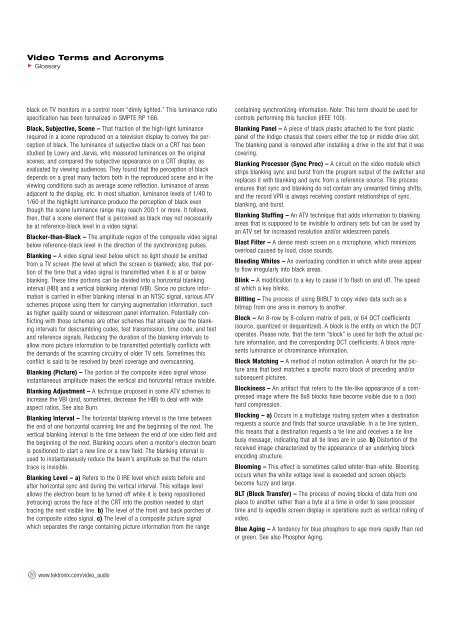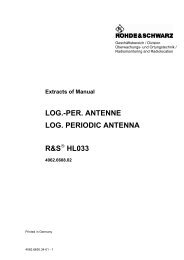Glossary of Video Terms and Acronyms - Isotest
Glossary of Video Terms and Acronyms - Isotest
Glossary of Video Terms and Acronyms - Isotest
You also want an ePaper? Increase the reach of your titles
YUMPU automatically turns print PDFs into web optimized ePapers that Google loves.
<strong>Video</strong> <strong>Terms</strong> <strong>and</strong> <strong>Acronyms</strong><br />
<strong>Glossary</strong><br />
black on TV monitors in a control room “dimly lighted.” This luminance ratio<br />
specification has been formalized in SMPTE RP 166.<br />
Black, Subjective, Scene – That fraction <strong>of</strong> the high-light luminance<br />
required in a scene reproduced on a television display to convey the perception<br />
<strong>of</strong> black. The luminance <strong>of</strong> subjective black on a CRT has been<br />
studied by Lowry <strong>and</strong> Jarvis, who measured luminances on the original<br />
scenes, <strong>and</strong> compared the subjective appearance on a CRT display, as<br />
evaluated by viewing audiences. They found that the perception <strong>of</strong> black<br />
depends on a great many factors both in the reproduced scene <strong>and</strong> in the<br />
viewing conditions such as average scene reflection, luminance <strong>of</strong> areas<br />
adjacent to the display, etc. In most situation, luminance levels <strong>of</strong> 1/40 to<br />
1/60 <strong>of</strong> the highlight luminance produce the perception <strong>of</strong> black even<br />
though the scene luminance range may reach 200:1 or more. It follows,<br />
then, that a scene element that is perceived as black may not necessarily<br />
be at reference-black level in a video signal.<br />
Blacker-than-Black – The amplitude region <strong>of</strong> the composite video signal<br />
below reference-black level in the direction <strong>of</strong> the synchronizing pulses.<br />
Blanking – A video signal level below which no light should be emitted<br />
from a TV screen (the level at which the screen is blanked); also, that portion<br />
<strong>of</strong> the time that a video signal is transmitted when it is at or below<br />
blanking. These time portions can be divided into a horizontal blanking<br />
interval (HBI) <strong>and</strong> a vertical blanking interval (VBI). Since no picture information<br />
is carried in either blanking interval in an NTSC signal, various ATV<br />
schemes propose using them for carrying augmentation information, such<br />
as higher quality sound or widescreen panel information. Potentially conflicting<br />
with those schemes are other schemes that already use the blanking<br />
intervals for descrambling codes, test transmission, time code, <strong>and</strong> test<br />
<strong>and</strong> reference signals. Reducing the duration <strong>of</strong> the blanking intervals to<br />
allow more picture information to be transmitted potentially conflicts with<br />
the dem<strong>and</strong>s <strong>of</strong> the scanning circuitry <strong>of</strong> older TV sets. Sometimes this<br />
conflict is said to be resolved by bezel coverage <strong>and</strong> overscanning.<br />
Blanking (Picture) – The portion <strong>of</strong> the composite video signal whose<br />
instantaneous amplitude makes the vertical <strong>and</strong> horizontal retrace invisible.<br />
Blanking Adjustment – A technique proposed in some ATV schemes to<br />
increase the VBI (<strong>and</strong>, sometimes, decrease the HBI) to deal with wide<br />
aspect ratios. See also Burn.<br />
Blanking Interval – The horizontal blanking interval is the time between<br />
the end <strong>of</strong> one horizontal scanning line <strong>and</strong> the beginning <strong>of</strong> the next. The<br />
vertical blanking interval is the time between the end <strong>of</strong> one video field <strong>and</strong><br />
the beginning <strong>of</strong> the next. Blanking occurs when a monitor’s electron beam<br />
is positioned to start a new line or a new field. The blanking interval is<br />
used to instantaneously reduce the beam’s amplitude so that the return<br />
trace is invisible.<br />
Blanking Level – a) Refers to the 0 IRE level which exists before <strong>and</strong><br />
after horizontal sync <strong>and</strong> during the vertical interval. This voltage level<br />
allows the electron beam to be turned <strong>of</strong>f while it is being repositioned<br />
(retracing) across the face <strong>of</strong> the CRT into the position needed to start<br />
tracing the next visible line. b) The level <strong>of</strong> the front <strong>and</strong> back porches <strong>of</strong><br />
the composite video signal. c) The level <strong>of</strong> a composite picture signal<br />
which separates the range containing picture information from the range<br />
20 www.tektronix.com/video_audio<br />
containing synchronizing information. Note: This term should be used for<br />
controls performing this function (IEEE 100).<br />
Blanking Panel – A piece <strong>of</strong> black plastic attached to the front plastic<br />
panel <strong>of</strong> the Indigo chassis that covers either the top or middle drive slot.<br />
The blanking panel is removed after installing a drive in the slot that it was<br />
covering.<br />
Blanking Processor (Sync Proc) – A circuit on the video module which<br />
strips blanking sync <strong>and</strong> burst from the program output <strong>of</strong> the switcher <strong>and</strong><br />
replaces it with blanking <strong>and</strong> sync from a reference source. This process<br />
ensures that sync <strong>and</strong> blanking do not contain any unwanted timing shifts,<br />
<strong>and</strong> the record VPR is always receiving constant relationships <strong>of</strong> sync,<br />
blanking, <strong>and</strong> burst.<br />
Blanking Stuffing – An ATV technique that adds information to blanking<br />
areas that is supposed to be invisible to ordinary sets but can be used by<br />
an ATV set for increased resolution <strong>and</strong>/or widescreen panels.<br />
Blast Filter – A dense mesh screen on a microphone, which minimizes<br />
overload caused by loud, close sounds.<br />
Bleeding Whites – An overloading condition in which white areas appear<br />
to flow irregularly into black areas.<br />
Blink – A modification to a key to cause it to flash on <strong>and</strong> <strong>of</strong>f. The speed<br />
at which a key blinks.<br />
Blitting – The process <strong>of</strong> using BitBLT to copy video data such as a<br />
bitmap from one area in memory to another.<br />
Block – An 8-row by 8-column matrix <strong>of</strong> pels, or 64 DCT coefficients<br />
(source, quantized or dequantized). A block is the entity on which the DCT<br />
operates. Please note, that the term “block” is used for both the actual picture<br />
information, <strong>and</strong> the corresponding DCT coefficients. A block represents<br />
luminance or chrominance information.<br />
Block Matching – A method <strong>of</strong> motion estimation. A search for the picture<br />
area that best matches a specific macro block <strong>of</strong> preceding <strong>and</strong>/or<br />
subsequent pictures.<br />
Blockiness – An artifact that refers to the tile-like appearance <strong>of</strong> a compressed<br />
image where the 8x8 blocks have become visible due to a (too)<br />
hard compression.<br />
Blocking – a) Occurs in a multistage routing system when a destination<br />
requests a source <strong>and</strong> finds that source unavailable. In a tie line system,<br />
this means that a destination requests a tie line <strong>and</strong> receives a tie line<br />
busy message, indicating that all tie lines are in use. b) Distortion <strong>of</strong> the<br />
received image characterized by the appearance <strong>of</strong> an underlying block<br />
encoding structure.<br />
Blooming – This effect is sometimes called whiter-than-white. Blooming<br />
occurs when the white voltage level is exceeded <strong>and</strong> screen objects<br />
become fuzzy <strong>and</strong> large.<br />
BLT (Block Transfer) – The process <strong>of</strong> moving blocks <strong>of</strong> data from one<br />
place to another rather than a byte at a time in order to save processor<br />
time <strong>and</strong> to expedite screen display in operations such as vertical rolling <strong>of</strong><br />
video.<br />
Blue Aging – A tendency for blue phosphors to age more rapidly than red<br />
or green. See also Phosphor Aging.





